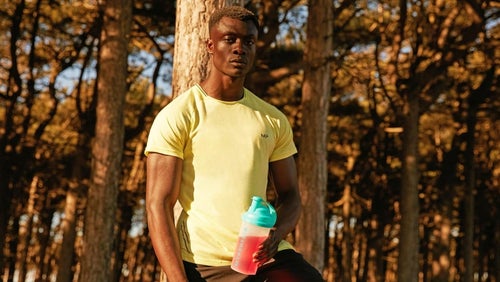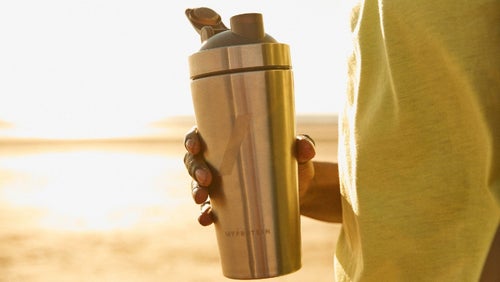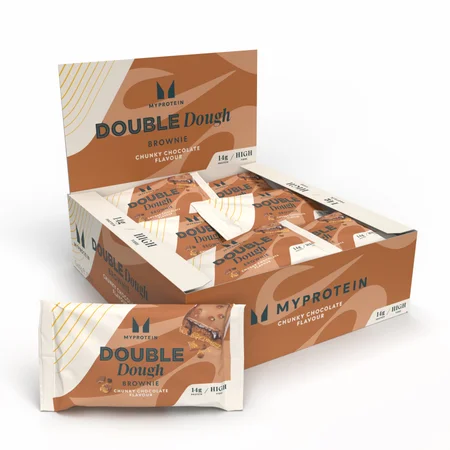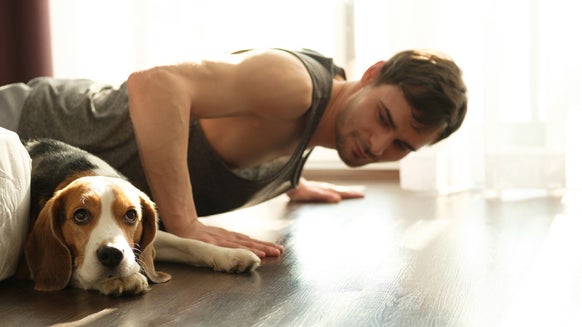Exercising In A Mask & Stopping Muscle Atrophy While Injured | Top Studies

Just because you can’t hit the gym right now doesn’t mean you can’t stay up to date on the latest training and nutrition science. Stay one step ahead of your gym buddies or PT clients with our helpful breakdown of the latest studies.
This week, we’re looking at making gains by only exercising one arm and what the science says about exercising in a face mask.
Exercising in a mask *won’t* disrupt your breathing

If the thought of being surrounded by people huffing and puffing has put you off returning to the gym, you might have considered wearing a face mask for a little extra protection. The question is, though, will you still be able to smash some cardio on the treadmill while wearing a face covering? The latest science says yes — here’s why.(1)
While you might be worried that you can’t get in enough oxygen, or that you’re re-breathing too much CO2, it turns out that even during vigorous exercise, you’ll be absolutely fine.
The researchers tested 14 physically healthy men and women while wearing 3-layered cloth masks. They controlled their sleep, diet, and activity levels in the 24 hours prior to the test and then had to perform a fitness test on a bike to exhaustion (anything between 6-12 minutes depending on fitness level).
Each participant did the test 3 times — once without a mask, once wearing a surgical face mask, and once wearing a cloth mask. Firstly, the researchers found that wearing a mask had no impact on the participants’ physical performance. They also found that there was minimal impact on blood and muscle oxygenation levels.
This means that while your face may feel a little extra sweaty, you can most likely work just as hard wearing your mask as you did before. If we all wear masks, could this mean that gyms won’t be top of the list for closing if cases climb again? Guess we’ll have to wait and see...
Exercise one arm for benefits in both

Ever injured an arm or leg but wondered if you should continue to train the other? Most of us have experienced the frustration of waiting for an injury to heal before we head back under the squat rack, but what would happen if you continued to train your healthy limbs?
According to new research, we can avoid muscles wasting away by continuing with a regime for the other arm or leg.(2) So, how does it work? In the study, 30 participants had one of their arms immobilised for a minimum of 8 hours a day for 4 weeks.
The group was then split into 3, with one group doing no exercise for the “healthy” arm, one group performing just eccentric exercises on the “healthy” arm, and the final group performing concentric and eccentric exercises on the “healthy” arm.
Eccentric exercises are when the contracted muscle is lengthening e.g. lowering a dumbbell in a bicep curl. Surprisingly, it was the group who performed just eccentric movements with a dumbbell who saw the biggest increase in muscle strength in both arms. That’s right — they saw less muscle wastage and an increase in strength in the immobilised arm too.
So, if you’ve hurt your wrist, broken your arm, or sprained your ankle, keep moving your other muscles and you may just a little less to make up when you’re recovered.
Take home message
Both studies are pretty small, so we’ll be keeping an eye out for more evidence to back up both. However, if you’re injured right now, that extra bit of hope and excuse to get moving again might just be the boost you need!
READ THIS NEXT:

Can Eating Later Lead To Weight Gain? | This Week's Top Studies
Find out this and more from this week's top studies.

Will A Cheat Meal Impact Your Goals? | This Week's Top Studies
Find out if you can really afford that cheat day.

Evangeline has taken part in competitive sports since a young age. As a qualified RYA Dinghy Instructor, she understands the importance of proper nutrition for fuelling extreme and endurance sports, especially due to her experience in Team GBR Squads and captaining and coaching her University first team.
In her spare time, Evangeline loves running – especially marathons. On the weekends, you’ll find her taking on water sports or hiking up a hill. Her favourite evenings are spent taking on a HIIT session or squats in the gym before digging into some spicy food and a ton of vegetables – yum!
Find out more about Evie's experience here.






